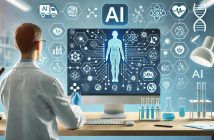From MRI-safe pacemakers to lung fluid vests, Noah Rue writes about the latest trends in medical device innovation.
Medical devices play an important role in helping patients manage their medical conditions. They also provide doctors and health practitioners with the information they need to follow their patient’s progress long after the office visit is over. Technology is ever-evolving to bring new, advanced developments in how patients and physicians can track medical conditions.
Medical devices do more than help a doctor or facility diagnose what is happening — they add a level of convenience for the patient that they never experienced before. A modern medical device could reduce the amount of time a person needs to spend at a doctor’s office, medical clinic, or hospital undergoing tests. Many diagnostics that used to be only performed in a clinic can now be measured remotely while the individual goes about their daily life. Let’s take a closer look at some current medical device trends and how they are impacting the healthcare sector.
1. Mobile Health Apps and Privacy
Regardless of the condition and device, going digital is an important aspect of the latest medical devices. Wearable tech or medical devices can monitor a patient’s health and track symptoms, but the information the device is recording is best managed by a medical professional. Apps can keep medical practitioners connected so they can keep abreast of how their patients are doing, without as many follow-up visits needed.
Patient confidentiality and privacy is critical. The Health Insurance Portability and Accountability Act (HIPAA) mandates that medical facilities and practitioners must safeguard the privacy of their patients’ confidential information. Do patients expose themselves to privacy violations if they’re using mobile phone apps to monitor, track, and share their medical data? It’s unlikely.
Apple has a wide variety of health and medical apps available. As of 2018, there were more than 300,000 health and medical apps on the market, and that number was projected to continue to skyrocket. Apple requires developers who are creating medical mobile apps to comply with HIPAA regulations.
According to Apple, developers in the process of creating a health or medical app must clearly disclose how a user’s information may be shared. They must also provide the user the ability to choose what parts of their medical and personal data collected they wish to disclose. This ensures that any information shared between a patient and a physician is agreed to and remains confidential. In addition, if you’re looking at a mobile app in the Apple Store or Google Play, the app has undergone stringent quality control reviews and testing before it was made available. You can rest assured the medical app you’re interested in downloading is safe and HIPAA-compliant.
2. New Tech Advancements for Diabetes
Diabetes is at the forefront of medical devices that track and monitor illnesses. For many diabetics, the disease interferes with their quality of life because of the demanding daily requirements to keep the condition under control. Many diabetes sufferers must take daily blood sugar readings, sometimes many times each day, to monitor blood sugar levels. More severe cases may need to perform the blood sugar readings as often as 10 times per day. The testing can be taxing, especially because of the pinpricks required to draw blood.
Then there’s the medication. Many patients take diabetes medication such as Toujeo, a form of insulin that must be injected, at least daily. In the case of testing and taking insulin shots, it’s all too easy to forget and accidentally skip a dose or reading. That’s where new technology comes in.
A new device is under development that could regulate Type 1 diabetes more effectively by delivering insulin automatically as needed. Known as a closed-loop delivery system, this technology is not a new concept. The FDA approved the first hybrid artificial pancreas version in 2016. The latest device under testing is known as Control-IQ system. It will use algorithms to adjust a patient’s insulin doses automatically so they no longer have to repeatedly test their blood sugar levels and remember to take their insulin injections.
3. New Advancements in Pacemakers
Millions of people worldwide wear a pacemaker. The life-saving medical device is essential to many but comes with the major inconvenience of needing surgery to have the battery replaced after several years.
There have been improvements in pacemaker technology in the last few years. Pacemakers now record device data which doctors can remotely view and monitor. Newer models are MRI-safe, which was a major issue for patients needing a magnetic resonance image before. In addition, the battery life in newer pacemaker devices lasts longer, delaying the need for surgery to replace the battery.
All surgeries come with risk. Even if the current advancements to extend battery life longer to delay the replacement surgery, it doesn’t eliminate a risky operation altogether. Fortunately, there are new advancements in the form of a self-charging pacemaker.
Engineers from Dartmouth College have developed a kit the size of a dime that could harness the kinetic energy your heart creates and convert it into power for your pacemaker. They just successfully completed its first round of animal testing. A self-charging pacemaker may be available in the next five years.
4. Heart Failure Detectors
Patients who are at high risk for heart failure are often implanted with a small device known as an ICD (Implantable cardioverter-defibrillator) or CRT-D (Cardiac Resynchronization Therapy Device). Boston Scientific’s HeartLogic device can be included in either ICD or CRT-D to predict heart failure weeks in advance. The HeartLogic device’s sensors monitor for the warning signs leading to heart failure. The tiny device is fitted with sensors that can track a patient’s vitals and heart rate, listen for changes in heart sounds, monitor respiration, and watch for shortness of breath.
Besides the HeartLogic device, there are other options using wearable tech that could track heart activity. For patients with less severe heart conditions, wearable tech, such as the Fitbit and Apple Watch, can track vital signs like heart rate. The tech may detect irregular heart rhythms which can lead to stroke or heart failure.
Another interesting medical device innovation: There is now a lung fluid vest available that measures the level of fluids inside a person’s lungs and monitors lung congestion levels to reduce the risk of heart failure. The alternative would be regular (and more invasive) chest X-rays. The wearable vest is more effective at identifying the condition before it’s too late without causing the patient too much inconvenience.
5. Wearable Tech
Wearable tech, such as the Apple Watch, FitBit, or lung fluid vest may be undergoing the greatest number of advancements. Its popularity may be due to the fact that it’s a far less invasive method, relative to other forms of monitoring and diagnosis.
Wearable devices not only enable patients to have a relatively normal quality of life, but they also improve the accuracy of the data collected. A person that’s wearing a monitor that’s small or comfortable enough to wear day and night can provide data during real-world conditions. The information collected could give a doctor better insight on habits or lifestyle choices that contribute to their patient’s health.
The Future of Medical Device Innovation
Although technology advances quickly, all medical devices and technologies must undergo years of testing before they’re approved for consumer use. Mobile apps using artificial intelligence (AI), such as Allo, have been around for the last few years, but AI’s venture into health applications is recent. The FDA recently approved the marketing of cardiac ultrasound software using artificial intelligence technology. Perhaps an AI medical device is in the pipeline.
As more devices and technologies clear the FDA’s process, AI is likely to play a greater role in medical devices transforming healthcare in the near future. Look for the expansion of wearable technology as well as more implementation of artificial intelligence. The future is certainly looking bright when it comes to the future of high-tech, innovative medical devices.
Need help to take your medical device innovation to market? Consult medical device specialists on Kolabtree. Post your project and get quotes for free.







